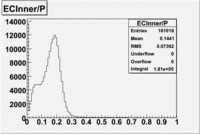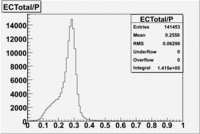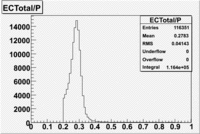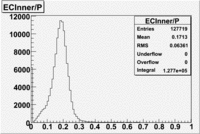Difference between revisions of "Analysis"
| Line 32: | Line 32: | ||
[[Image:Einner_over_P_using_both_cuts.gif | 200 px]]<br> | [[Image:Einner_over_P_using_both_cuts.gif | 200 px]]<br> | ||
| − | + | ==== summary table==== | |
==Pion== | ==Pion== | ||
=Quality Checks= | =Quality Checks= | ||
==Rates== | ==Rates== | ||
==Asymmetries== | ==Asymmetries== | ||
Revision as of 21:44, 6 August 2007
Particle Identification
Electron
Cuts
Calorimeter based cuts
The distributions below represent two types of cuts applied to improve the electron particle identification (PID) using a 4 GeV electron beam incident on an NH3 target. The electron calorimeter is segmented into an inner and an outer region. The total energy absorbed by the calorimeter system is recorded in the variable . The momentum () is calculated using the reconstructed track and the known torus magnetic field. The distributions of and are shown below where both have been divided by the electron momentum and no cuts have been applied.
Without any cuts we have 181018 entries. After using the following cut we are getting 127719 entries, which is about 70.55% of 181018.
After the cut on the energy deposited into inner part of electron calorimeter, number of entries decreases by 22%.
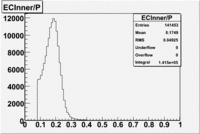
Both cuts are applied
In case of using the cuts of the total deposited energy and the energy deposited into inner calorimeter number of entries decreases ~36%
